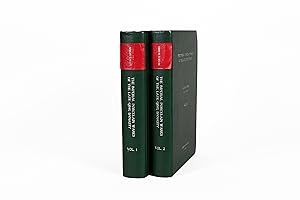kwan simon s m (1 Ergebnisse)
Produktart
- Alle Produktarten
- Bücher (1)
- Magazine & Zeitschriften
- Comics
- Noten
- Kunst, Grafik & Poster
- Fotografien
- Karten
-
Manuskripte &
Papierantiquitäten
Zustand
- Alle
- Neu
- Antiquarisch/Gebraucht
Einband
- alle Einbände
- Hardcover
- Softcover
Weitere Eigenschaften
- Erstausgabe
- Signiert
- Schutzumschlag
- Angebotsfoto
- Kein Print-on-Demand
Land des Verkäufers
Verkäuferbewertung
-
The Imperial Porcelain Wares of the Late Qing Dynasty (2 volumes)
Verlag: University of Hong Kong, 1989
Anbieter: Jorge Welsh Books, Lisboa, Portugal
Buch Erstausgabe
Hardcover. Zustand: Good. No Jacket. 1st Edition. English text; Hardcover (without dust jacket); 22 x 29.8 cm; 4.6 Kg; Volume 1 with 407 pages; Volume 2, pages 408 to 487 followed by a list of 276 plates (each with caption) from the author collection comprising Wares from Daoguang, Xiaofeng, Tongzhi, Guangxu and Xuantong. Black and white illustrations throughout.; Used with signs of wear on the exterior and interior. The hardcover front covers is turning inwards at the top right side. Both volumes include a sticker with the author name on spine, which is slightly ungluing on volume 1.; Abstract of thesis entitled: "The Imperial Porcelain Wares of the Late Qing Dynasty" submitted by Simon S. M. Kwan for the degree of Doctor of Philosophy at the University of Hong Kong, July, 1989. This thesis is devoted to the study of Qing ceramics from the reign of Daoguang (1821.1850) to the reign of Xuantong (1909-1911), covering a period of approximately ninety years. During this period, the ceramic art of China was dominated by the work of the Imperial Porcelain Factory. This Factory was responsible for the production of practically all the ceramic wares required by the imperial court. The Imperial Porcelain Factory of the late Qing period, or the "Imperial Kilns" as it was commonly called, was located in Jingdezhen, near Zhushan. Two versions of the annual production catalogues of the Factory are available today. One belongs to the reign of Tongzhi (1862-1874) and the other one belongs to the reign of Guangxu (1875-1908). Items mentioned in these two catalogues have been almost completely identified and are illustrated in this thesis. Ceramic wares produced by the Imperial Factory, that is, the imperial wares, may be classified into these main categories, ritual vessels, domestic wares and special items. Designs for all these wares were prepared at the imperial palace under the direct control of the Emperor and the Department of Works. Drawings and wooden models were made in Beijing and sent to Jingdezhen from time to time. Sample pieces were made by the Factory and returned to the palace for approval and ordering. The Imperial Porcelain Factory of the late Qing period was a fully equipped establishment of producing ceramic wares from the raw clay stage to the fully decorated city bodies ready for firing. However, the actual work of the firing on a consignment basis. Firing kilns for these wares were the egg-shaped kilns of Jingdezhen and the firing material was the wood of pine trees. Decoration and design of the Imperial wares of late Qing were substantially based on the designs of the Ming and early Qing period. However, there were other innovative designs and decorative techniques developed during this period. Finally, almost every one of the imperial wares of this period carries an imperial mark. As these marks are identifiable as being written by a very limited number of mark-writers at the Factory, they serve as an important guide for the authentication of the Imperial porcelain wares of the late Qing dynasty.


